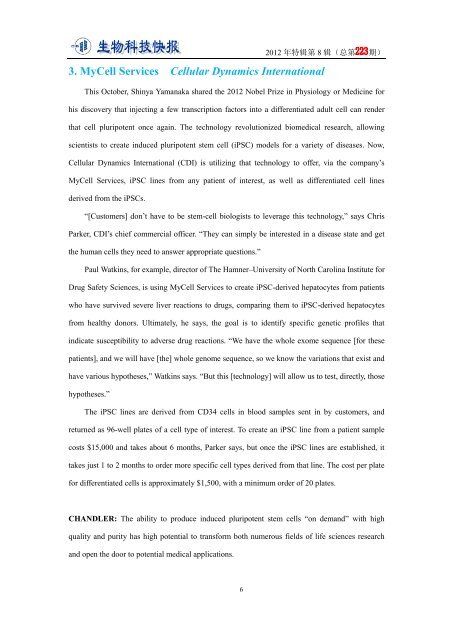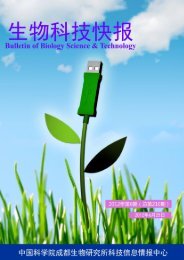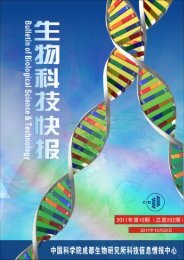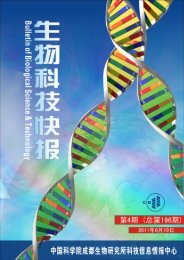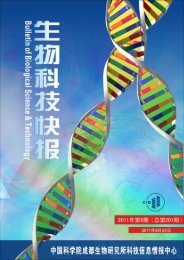2012 生命科学10 大创新 - 中国科学院成都生物研究所科技信息情报中心
2012 生命科学10 大创新 - 中国科学院成都生物研究所科技信息情报中心
2012 生命科学10 大创新 - 中国科学院成都生物研究所科技信息情报中心
You also want an ePaper? Increase the reach of your titles
YUMPU automatically turns print PDFs into web optimized ePapers that Google loves.
3. MyCell Services Cellular Dynamics International<br />
<strong>2012</strong> 年 特 辑 第 8 辑 ( 总 第 期 )<br />
This October, Shinya Yamanaka shared the <strong>2012</strong> Nobel Prize in Physiology or Medicine for<br />
his discovery that injecting a few transcription factors into a differentiated adult cell can render<br />
that cell pluripotent once again. The technology revolutionized biomedical research, allowing<br />
scientists to create induced pluripotent stem cell (iPSC) models for a variety of diseases. Now,<br />
Cellular Dynamics International (CDI) is utilizing that technology to offer, via the company’s<br />
MyCell Services, iPSC lines from any patient of interest, as well as differentiated cell lines<br />
derived from the iPSCs.<br />
“[Customers] don’t have to be stem-cell biologists to leverage this technology,” says Chris<br />
Parker, CDI’s chief commercial officer. “They can simply be interested in a disease state and get<br />
the human cells they need to answer appropriate questions.”<br />
Paul Watkins, for example, director of The Hamner–University of North Carolina Institute for<br />
Drug Safety Sciences, is using MyCell Services to create iPSC-derived hepatocytes from patients<br />
who have survived severe liver reactions to drugs, comparing them to iPSC-derived hepatocytes<br />
from healthy donors. Ultimately, he says, the goal is to identify specific genetic profiles that<br />
indicate susceptibility to adverse drug reactions. “We have the whole exome sequence [for these<br />
patients], and we will have [the] whole genome sequence, so we know the variations that exist and<br />
have various hypotheses,” Watkins says. “But this [technology] will allow us to test, directly, those<br />
hypotheses.”<br />
The iPSC lines are derived from CD34 cells in blood samples sent in by customers, and<br />
returned as 96-well plates of a cell type of interest. To create an iPSC line from a patient sample<br />
costs $15,000 and takes about 6 months, Parker says, but once the iPSC lines are established, it<br />
takes just 1 to 2 months to order more specific cell types derived from that line. The cost per plate<br />
for differentiated cells is approximately $1,500, with a minimum order of 20 plates.<br />
CHANDLER: The ability to produce induced pluripotent stem cells “on demand” with high<br />
quality and purity has high potential to transform both numerous fields of life sciences research<br />
and open the door to potential medical applications.<br />
6


